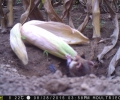From studying behaviour to designing the A.P.T.
7 février 2019The study of animal behaviour is essential in order to understand why some installations are unsuitable and how to create solutions. By observing the activity around wildlife crossings, which are very common in Alsace to enable animals to cross the barriers that roads create, researchers deduced that these installations are ineffective for small animals, and can even be dangerous.
Deadly crossings
Wildlife crossings can be different sizes, they are sometimes tunnels with a lane for agricultural machines. By studying the visitors to these installations in more detail, it was found that small animals rarely used these large-scale crossings due to a feeling of insecurity. They prefer narrower passages. However, narrower passages can sometimes be deadly traps where wily predators (cats, foxes, etc.) wait at the end for prey species such as the European Hamster, field mice and other small mammals (Study by J. Jumeau and Y. Handrich, CNRS-DREAL, 2013)
A bright idea
Could there be a way to enable these small animals to cross barriers while reducing the risk of predation? The idea was to design a system that could be incorporated into existing wildlife crossings. A tube that the animal could use to cross while feeling safe, or at least take shelter in the event of imminent danger. This was the subject Yves Handrich’s team worked on within the LIFE Alister project (M. Tissier, J. Jumeau & Y. Handrich, CNRS-DREA, Life ALISTER, 2013-2017). The tube’s diameter was a suitable size for European Hamster crossings, with lateral openings to enable these prey animals to enter the tube at any moment during the crossing.
A system tested in a laboratory and in an enclosure in a nature site
The A.P.T. (Anti-Predation Tube) was tested in laboratory conditions, both with and without confrontation with a live predator (mobile or immobile). It was also tested in a wildlife crossing where both ends were fenced in. The European Hamsters lived there in comparatively wild conditions. As these animals quickly return to their behaviour in the wild, this situation means they can be observed in a near-natural environment, such as it would be if they were in the wild.

Cameras and camera traps in the tunnel meant researchers could study the animals’ behaviour while they were crossing the tunnel, as well as in the presence of a predator; the predator used was a house marten, in a cage of course.
What are the results of these tests today?
-
For European Hamsters:
-
Adding an APT in the Hamsterducts does not significantly speed up the crossing time
-
In the presence of a predator, males use the APT more frequently, there is not a significant change for females
-
Improved responses for individuals who were ‘acclimatised with a nature course’ (results not yet published)
For similar small animals
-
Significant increase in crossings where there is an APT, but only in large-scale crossings
-
Small mammals use the APT freely, but stoats and weasels also use it
These overall results are sufficiently conclusive for the CNRS (French National Centre for Scientific Research) to publish recommendations:
-
APT, which are inexpensive and easy to maintain, should be installed in all wildlife crossings for hamsters and in agricultural underpasses
-
Tests should be continued on a wider range of animals before widespread installation in all types of crossings for small animals
-
The question of the future installation of APTs inside wildlife crossings in areas where hamsters are present will be put to the DREAL Route (Regional Department for the Environment, Planning and Accommodation) during the next NPA (National Plan of Action) in favour of the European Hamster.




